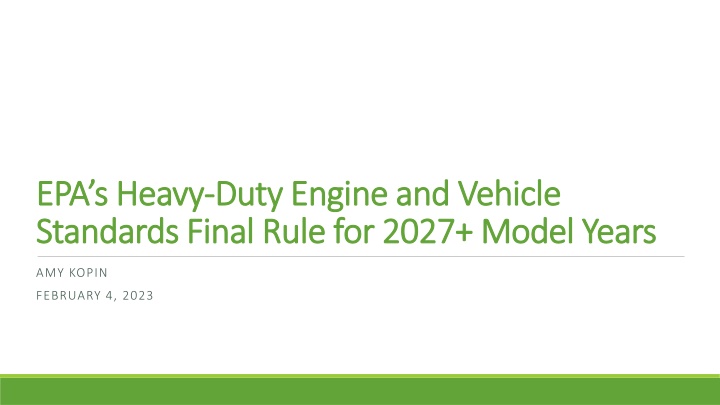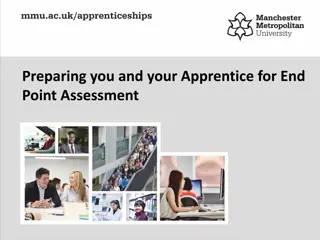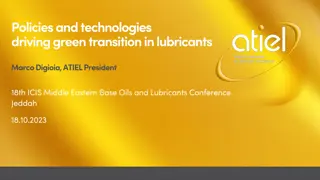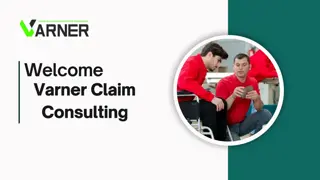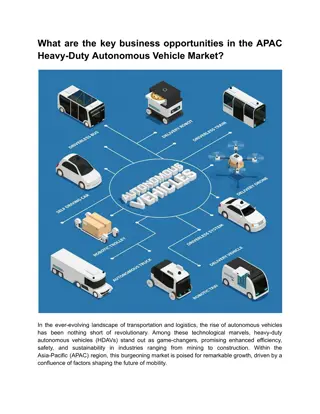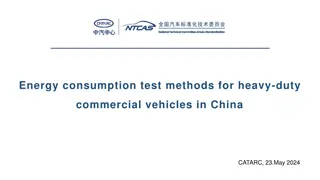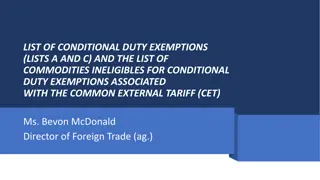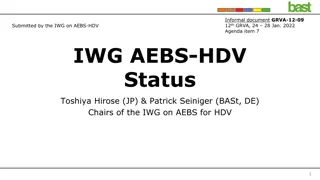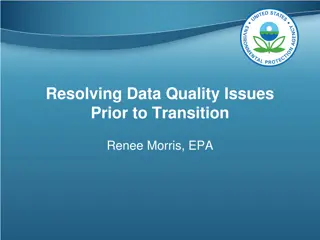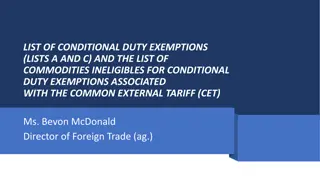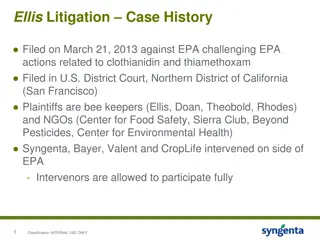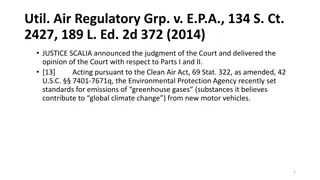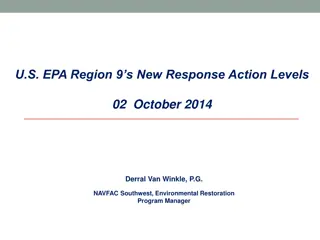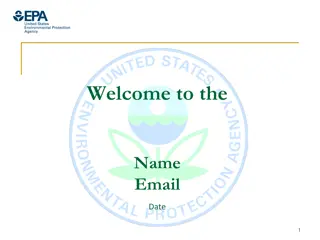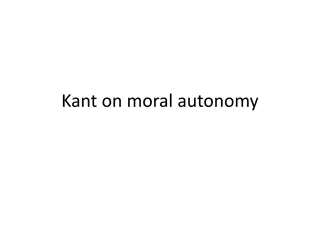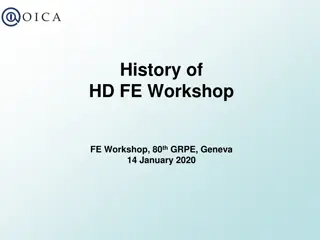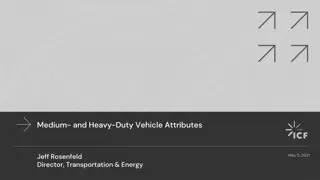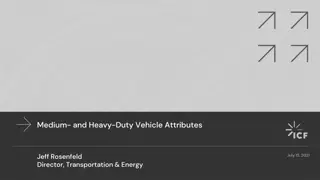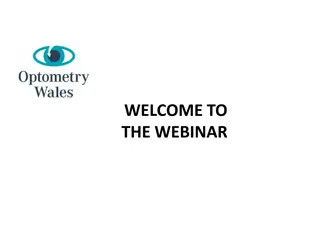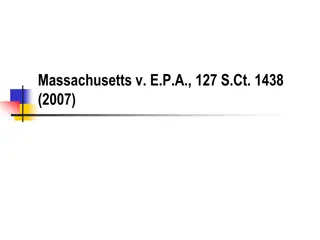EPA's Heavy-Duty Engine & Vehicle Standards for 2027+ Model Years
The EPA has finalized new standards for heavy-duty engines and vehicles starting from 2027 onwards. The rules cover aspects such as test procedures, emission standards, regulatory useful life, and warranty, aiming to reduce emissions and improve serviceability. Manufacturers must comply with the program by 2027, with updates to maintenance, onboard diagnostics, and engine derating requirements outlined. This regulation addresses diverse heavy-duty vehicles' impact on air pollution and aims to achieve significant emission reductions.
Download Presentation

Please find below an Image/Link to download the presentation.
The content on the website is provided AS IS for your information and personal use only. It may not be sold, licensed, or shared on other websites without obtaining consent from the author.If you encounter any issues during the download, it is possible that the publisher has removed the file from their server.
You are allowed to download the files provided on this website for personal or commercial use, subject to the condition that they are used lawfully. All files are the property of their respective owners.
The content on the website is provided AS IS for your information and personal use only. It may not be sold, licensed, or shared on other websites without obtaining consent from the author.
E N D
Presentation Transcript
EPAs Heavy EPA s Heavy- -Duty Engine and Vehicle Duty Engine and Vehicle Standards Final Rule for 2027+ Model Years Standards Final Rule for 2027+ Model Years AMY KOPIN FEBRUARY 4, 2023
Agenda Agenda o Rule Overview o Inducements o Serviceability and Onboard Diagnostics Improvements o Next Steps February 2023
Rule Overview February 2023
EPAs Heavy-Duty 2027 Final Rule o EPA Administrator signed the Notice of Proposed Rulemaking (NPRM) on March 7, 2022, and the Final Rulemaking (FRM) on December 20, 2022 o Manufacturers must comply with the final program beginning in Model Year (MY) 2027 o No final action on the proposed targeted updates to the existing Heavy-Duty GHG Phase 2 program (intend to propose in GHG Phase 3 rule this year) o FRM Published in the Federal register on January 24, 2023 88 FR 4296, https://www.govinfo.gov/content/pkg/FR-2023-01-24/pdf/2022-27957.pdf EPA webpage for more information https://www.epa.gov/regulations-emissions-vehicles-and- engines/final-rule-and-related-materials-control-air-pollution February 2023 4
Context for EPA Heavy-Duty 2027 Final Rule o The heavy-duty industry is diverse, spanning delivery trucks, tractor-trailers, school buses, and other types of vocational vehicles o Heavy-duty vehicles contribute significantly to local, regional, and global air pollution o The Clean Air Act gives EPA authority to set standards for HC, CO, NOx, and PM for heavy-duty These standards must achieve the greatest degree of emission reduction achievable , and provide a minimum of 4 years lead-time, and 3 years of stability between new standards EPA s last heavy-duty rulemaking for these pollutants was over 20 years ago, with standards that phased in through 2010. February 2023 5
Major Elements of the Final Rule o Changes to 4 key elements of heavy-duty engine criteria pollutant program 1) Test Procedures, 2) Emission Standards, 3) Regulatory Useful Life, & 4) Emissions Warranty o Updated Averaging, Banking, and Trading (ABT) program o New maintenance, serviceability, and onboard diagnostics (OBD) requirements to help owners: Access more maintenance information to facilitate repairs Quickly identify failed emissions control parts Limit frustration, cost, and downtime due to repairs o New regulations for engine derating related to SCR-based systems Ensure that all critical emission related scheduled maintenance has a reasonable likelihood of being performed while also deterring tampering of the SCR system. Set an appropriate inducement speed derating schedule that reflects experience gained over the past decade with SCR systems February 2023 6
New Test Procedures and Emission Standards o For all engine categories, the final standards are a single-step, beginning in MY 2027 Lower standards over laboratory current duty cycles New low-load cycle and standards for compression-ignition engines covering stop-and-go and idle operation to help address emissions from urban driving conditions New supplemental emission test cycle and standards for spark-ignition engines covering sustained higher speed and higher load operation to help reduce fuel enrichment under highway driving conditions o For in-use Medium HDE or Heavy HDE, EPA included a compliance allowance that applies when EPA evaluates whether engines are meeting the final standards after these engines are in the real world Compression-ignition HDE NOx Standards (mg NOx /brake hp-h) MY 2027+ In-Use Compliance Allowance Spark-ignition HDE NOx Standards (mg NOx /brake hp-h) Current MY 2027+ Current MY 2027+ Federal Test Procedure (transient mid/high load conditions) Supplemental Emission Test (steady-state conditions) 200 35 Federal Test Procedure (transient mid/high load conditions) Supplemental Emission Test (steady-state conditions) Low Load Cycle (low-load conditions) 200 35 50 N/A 35 200 35 50 N/A 50 65 February 2023 7
Longer Regulatory Useful Life Periods o Longer useful life periods ensure engines are designed to meet emission standards through more of their operational lives o Our final useful life periods are generally based on average mileage at time of rebuild or replacement o Useful life periods have been increased for all engine categories starting in MY 2027 Current MY 2027+ Primary Intended Service Class Miles Years Hours Miles Years Hours Spark-ignition HDE 110,000 10 - 200,000 15 10,000 Light HDE 110,000 10 - 270,000 15 13,000 Medium HDE 185,000 10 - 350,000 12 17,000 Heavy HDE 435,000 10 22,000 650,000 11 32,000 February 2023 8
Longer Emission-Related Warranty Periods o Warranty ensures end-users don t bear all the risk of emission technologies that fail prematurely o We lengthened warranty, in part, because owners are more likely to repair and maintain their emission controls, and less likely to tamper, if emission controls are covered by warranty o Warranty periods have been increased for all engine categories starting in MY 2027 Current MY 2027+ Primary intended Service Class Mileage Years Hours Mileage Years Hours Spark-ignition HDE 50,000 5 - 160,000 10 8,000 Light HDE 50,000 5 - 210,000 10 10,000 Medium HDE 100,000 5 - 280,000 10 14,000 Heavy HDE 100,000 5 - 450,000 10 22,000 February 2023 9
Inducements February 2023
SCR Inducement Proposal Background o SCR is very different from other emission control technologies in that it requires operators maintain an adequate supply of diesel exhaust fluid ( DEF ) o Operating an SCR-equipped engine without DEF would cause NOX emissions to increase to levels comparable to having no NOX controls at all o In response to this concern, EPA issued guidance describing how manufacturers could use engine derates or inducements for certain DEF-related faults to ensure that operators use an adequate supply of high-quality DEF o Today manufacturers design engines with a 5-mph final inducement for many reasons unrelated to DEF refills, and once a vehicle reaches final severe inducement it generally must be towed to a specialized repair facility to have the condition reset February 2023 11
Proposed Inducement Schedules Proposed Inducement Schedules o Proposed inducement schedules Two separate categories and final inducement speeds one schedule o To ensure vehicles that operate primarily off the highway and in urban areas have an appropriate low final inducement speed, and o properly qualified high-speed vehicles cannot operate commercially on the highway o Comments received on NPRM Operators confirmed proposed derate schedule would be effective, but wanted more time and more speed Other commenters suggested less time & lower final speeds were more appropriate February 2023
Inducements in the FRM Inducements in the FRM o EPA expects SCR will continue to be used to meet new standards o FRM includes several changes from proposal after consideration of comments Added a third speed category (low-, medium-, and high-speed vehicle inducements) Revised inducements speeds and schedules Does not include a NOx override Includes a separate schedule for engines used in motorcoaches o The final inducement program is mandatory for MY 2027 engines, but can be used voluntary before then February 2023
Inducement Requirements Inducement Requirements o Triggers Three categories: DEF Supply is Low, DEF Quality Problems, and Tampering Tampering is defined as open circuit faults for specific components or missing catalysts o Driver Information EPA is requiring additional information be provided to the driver to help operators and owners to make timely and informed decisions, including: the condition causing the derate (e.g., DEF quality, tampering or level), the fault code and description of code associated w/inducement, the current speed restriction, and the next derate step and speed o Removing Inducements EPA is requiring engines self heal if the fault condition is confirmed to be remedied FRM allows for a generic scantool to be used to remove the condition Repeat Faults are subject to immediate reevaluation that would lead to resuming the derate where it left off if a code persists within 40h of first appearance February 2023
Final Rule Inducement Schedules Final Rule Inducement Schedules o Inducement category is based on average speed over last 30 hours of non-idle operation speed Low speed vehicles are defined as having average operating speed of <15mph and a high-speed vehicles 25 o There is a speed transition between steps of 1mph /5mins (prior to each step and before any repeat inducement) February 2023
Inducements for Motorcoaches Inducements for Motorcoaches o Motorcoach operators submitted comments describing a greater sensitivity to any speed derate because of a much greater responsibility for carrying people safely to their intended destinations over longer distances, including their role in emergency response and national defense operations o EPA defines motorcoaches in 40 CFR 1036.801 to include buses that are designed to travel long distances with row seating for at least 30 passengers. This is intended to include charter services available to the general public. Motorcoach Inducement Schedule Hours of non-idle engine operation Maximum Speed 0 65mph 80 50mph 180 25mph February 2023
Inducements and Existing Vehicles Inducements and Existing Vehicles o As stated in the FRM Preamble: EPA believes field fixes with updated inducement algorithms may fall within EPA s field fix guidance for engines that have EPA-only certification (i.e., does not include certification to California standards), but has concerns about such field fixes falling within the scope of the guidance for engines also certified by CARB if CARB considers such changes to be tampering with respect to requirements that apply in California. EPA intends to also consider alternative field fix inducement approaches that manufacturers choose to develop and propose to CARB and EPA, for engines certified by both EPA and CARB, such as approaches that provide a more balanced inducement strategy than that used in current certifications while still being effective. o EPA would consider approaches that do not include all aspects of the FRM inducement program o EPA can only approve changes to EPA-only certified engines February 2023
Serviceability and OBD Provisions February 2023
Finalized Serviceability Improvements More repair and servicing information in owner s manual, including: 1. A description of how the emission control systems operate Figure used with permission from John Deere 2. Diagrams of the engine and emission-related components: Showing the flowpath of air, exhaust, coolant, DEF Identify location of relevant emission sensors, DEF heater and delivery components, and other critical emissions components (terminology must be consistent with OBD) Include part numbers for emission sensors and filters 3. A description of how to use the OBD system to troubleshoot problems and access emission-related diagnostic information For example, what OBD protocol used and where the connector is February 2023 19
Finalized Serviceability Improvements o A troubleshooting guide to address SCR inducement-related and DPF regeneration- related warning signals For the SCR system this requirement includes: derate schedule , the meaning of any trouble lights that indicate specific problems (e.g., DEF level) and a description of the three types of SCR-related derates For the DPF system the troubleshooting guide requirement includes information on the occurrence of DPF-related derates o Improved information displayed on demand Average DEF consumption (historical and current w/an available reset) Total number of regens on the existing DPF Type of derate and fault code for other SCR- and DPF-related engine derates (speed or torque) o Provide instructions on where to find emission recall and technical repair information that is available without charge o Changes are mandatory for MY 2027 and voluntary before then February 2023 20
Onboard Diagnostics o EPA largely harmonized with existing California Air Resources Board (CARB) OBD requirements o EPA finalized additional emission-related parameters to include in freeze frame data Freeze frame data is a set of parameters taken as a snapshot when a trouble code is set o EPA also finalized additional data parameters be made public Access to emission-related data parameters is critical for prompt and proper repair Provides more information and value to owner while simultaneously help achieve long term emission benefits All data parameters used in an engine s decision process to put vehicle into an SCR- or DPF-related derate must also be made publicly available February 2023 21
Next Steps o EPA is currently working on a Heavy-Duty Phase 3 GHG proposal Goal is to issue an NPRM in March 2023 and a Final rule in December 2023 More information on EPA s Heavy-duty GHG regulations can be found here: https://www.epa.gov/regulations-emissions-vehicles-and-engines/regulations- greenhouse-gas-emissions-commercial-trucks o We look forward to getting input from stakeholders on the program There will be a public comment period and a public hearing later this spring February 2023 22
Questions? February 2023 23
